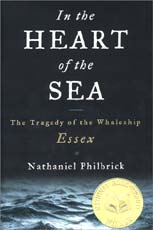|
The
exploits of those who have sailed the open seas have always captured
the public’s fascination. One of the most incredible stories to
emerge from the annals of seafaring history is that of the 19th
century American whale ship Essex, a story described in Nathaniel
Philbrick’s book "In the Heart of the Sea."
Sailing
from Nantucket, Mass., on Aug. 12, 1819, the Essex and its crew
experienced an unimaginable event when, on Nov. 20, 1820, a huge
sperm whale rammed the ship on two successive attacks. The attack
forced the crew to abandon the sinking ship and face the vast
emptiness of the Pacific Ocean.
Their
odyssey slowly disintegrated into a sailor’s worst nightmare:
starvation, madness and death while lost on the sea. The most
shocking aspect of this episode was the murder and cannibalism of
some of the shipmates in order to sustain the survivors. By the time
the remaining crew members were located in February 1821, their
rescuers encountered men resembling human skeletons who were barely
clinging to life.

The
accounts of this harrowing experience captured the attention of a
writer who had gone to sea for adventure: Herman Melville. Melville
shared an interest in the seafaring life and the whaling industry,
and he used the Essex incident as the inspiration for the climactic
scene in his novel "Moby Dick."
As
a hunting vessel the Essex represented a 19th century
version of a floating processing factory. She was designed to carry
a working crew and the supplies needed to conduct a whale hunt
lasting up to three years. During that time the crew was expected to
harpoon and kill sperm whales and process them for their precious
oil. This processing would involve removing the blubber, chopping it
up and boiling it to extract the oil. The ships were built and
outfitted out of Nantucket, one of the principal centers of the
North American whaling industry.
Whaling
was an extremely dangerous profession. As Philbrick notes,
"That all of this was conducted on the limitless Pacific Ocean
meant that the whalemen of the early 19th century were
not merely seagoing hunters and factory workers but also explorers,
pushing out farther and farther into a scarcely charted
wilderness."
It
is the actual whale hunt that provided the greatest danger to the
men and their ship. Philbrick describes the dangers:
"Harvesting sperm whales…was no easy matter. Six men would
set out from the ship in a small boat, row up to their prey, harpoon
it, then attempt to stab it to death with a lance. The sixty ton
creature could destroy the whaleboat with a flick of its tail,
throwing the men into the cold ocean water, often miles from the
ship."
[to top of second column in
this review]
|

These
are the circumstances under which the 21-member crew of the Essex
found themselves as they roamed the Pacific Ocean in search of these
"warm blooded oil deposits." It was during one of these
routine hunts that the ship encountered the 85-foot whale that
attacked the Essex.
The
account of the attack and the crew’s subsequent ordeal was
recounted by the survivors and, later on, in two written narratives.
First Mate Owen Chase and cabin boy Thomas Nickerson wrote of their
experiences in published accounts that remain with us to this day.
One
of the most poignant moments in Nickerson’s account comes in his
description of the attack on the Essex. According to Nickerson,
First Mate Chase had the opportunity to slay the whale after the
first attack — but he hesitated. Because it was near the ship’s
rudder, Chase feared that the injured whale might damage the
steering device and send the ship helplessly adrift in the Pacific.
Chase held off, allowing the whale to launch its second attack. It
was the second attack that left the Essex damaged beyond repair,
forcing the crew to abandon ship and take their chances on the open
sea.
In
his account of the attack, Nickerson wrote, "But could [Chase]
have foreseen all that so soon followed he probably would have
chosen the lesser evil and have saved the ship by killing the whale
even at the expense of losing the rudder." Although he never
mentioned it in his own narrative, Chase probably thought the same
thing. In the end a rudderless ship would have been preferable to
the horror that awaited them.

"In
the Heart of the Sea" is an exciting and gripping narrative of
one of the most famous events in seafaring history. Philbrick’s
thorough documentation and research bring to life the perilous world
of 19th century whale hunting. The story of the ill-fated
voyage of the Essex, once relegated to the shadows of history, has
been masterfully retold in the grand tradition of a seafaring
adventure. "In the Heart of the Sea" is highly recommended
to all adult and young adult readers.
For
more information visit the library at 725 Pekin St. or call
217-732-8878.
[Richard
Sumrall, Lincoln Public Library District]
|

